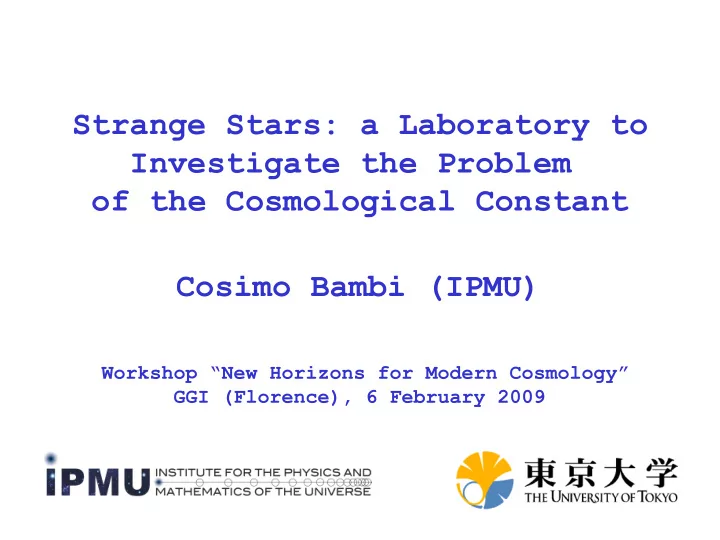

Strange Stars: a Laboratory to Investigate the Problem of the Cosmological Constant Cosimo Bambi (IPMU) Workshop “New Horizons for Modern Cosmology” GGI (Florence), 6 February 2009
Plan of the Talk • The “old” problem of the cosmological constant • What is a strange star? • Strange stars may be used as laboratory to investigate the “old” problem of the cosmological constant! • Conclusions C. Bambi, JCAP 06 (2007) 006 [arXiv:0704.2126] Cosimo Bambi, IPMU 2
Sources of the “Effective” Cosmological Constant in the Universe • Bare cosmological constant • Vacuum energy of quantum matter (after regularization, ren is a free parameter to be determined by experiments) • Vacuum energy from spontaneously broken symmetries (chiral symmetry (QCD), electroweak symmetry (Higgs), GUT (?),… likely the most suspicious contributions!!!) Cosimo Bambi, IPMU 3
Standard picture of the Universe: after several phase transitions the vacuum energy density is (almost) zero!? GUT (?) Inflation (?) Other PT? Effective EW cosmological constant QCD 100 GeV 100 MeV DE? Time Cosimo Bambi, IPMU 4
Two Basic Solutions to the Puzzle of the Cosmological Constant • Special initial conditions: we live in a very peculiar Universe! (Anthropic Principle?) • Special properties of the vacuum energy density: there is something we do not know. Some proposals: compensating fields, violation of the Equivalence Principle,… Cosimo Bambi, IPMU 5
QCD Vacuum • QCD Lagrangian The QCD vacuum is an observational fact! See e.g. the Gellmann-Renner-Oakes relation Cosimo Bambi, IPMU 6
Deconfined Phase • Quark matter energy-momentum tensor • B is the energy density difference between the QCD vacua of the deconfined and confined phase • In General B is NOT the Bag Constant we can deduce from hadron spectroscopy! Cosimo Bambi, IPMU 7
Quark Matter May be Stable • The introduction of a third flavor can reduce the energy of the system (quarks are fermions!) • Even if quark matter is meta-stable at zero pressure, it may be stabilized at higher pressure • Quark stars (stars made of quark matter) or hybrid stars (stars with a core of quark matter and an outer part of hadron matter) may exist • Quark/hybrid stars may be formed during the proto- neutron star phase or later, when the neutron star has become heavier after accretion Cosimo Bambi, IPMU 8
The stellar equilibrium is determined by the balance between the gravitational force and the gas pressure. If quark stars exist, we could test if the QCD vacuum is or is not a source of the gravitational field • TOV equations: • Boundary conditions: Cosimo Bambi, IPMU 9
Mass – Radius Relation Red solid line: QCD vacuum energy density is not source of the gravitational field Blue dashed line: standard picture Cosimo Bambi, IPMU 10
Baryon Number – Mass Relation Red solid line: QCD vacuum energy density is not source of the gravitational field Blue dashed line: standard picture Cosimo Bambi, IPMU 11
How Can We Distinguish a Quark Star from a Neutron Star? • “Crusted” quark stars are expected to have emission properties similar to neutron stars • Maximum mass? • Mass-radius relation? • Gravitational waves? Neutrino flux? …? • Clear signature: quark stars can rotate faster than neutron stars (higher viscosity which prevents r-mode instabilities) Cosimo Bambi, IPMU 12
XTE J1739-285 • X-ray transient discovered at the end of 2006 • Burst oscillations at 1122 Hz • If the burst oscillation frequency is equal to the stellar spin rate, we have discovered the first sub-millisecond compact stars • In this case XTE J1739-285 has to be an hybrid star or quark star! Cosimo Bambi, IPMU 13
Conclusions • Basic questions: Do we live in a very special Universe? Has the vacuum energy very peculiar (and unknown) properties? Can we test the two classes of solutions? • The equilibrium configuration of quark stars depends on the QCD vacuum energy density, but actually there are good reasons to believe that we do not know the gravitational properties of the vacuum • Message 1: Quark stars may be used to investigate the problem of the cosmological constant • Message 2: Quark stars may be quite different from the objects discussed in the literature Cosimo Bambi, IPMU 14
Recommend
More recommend